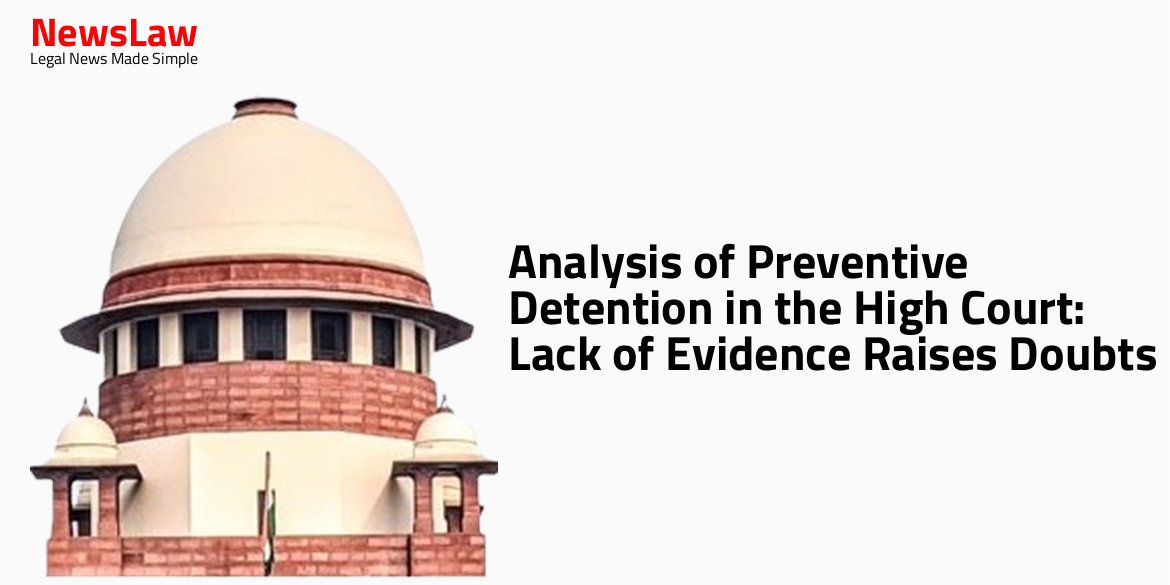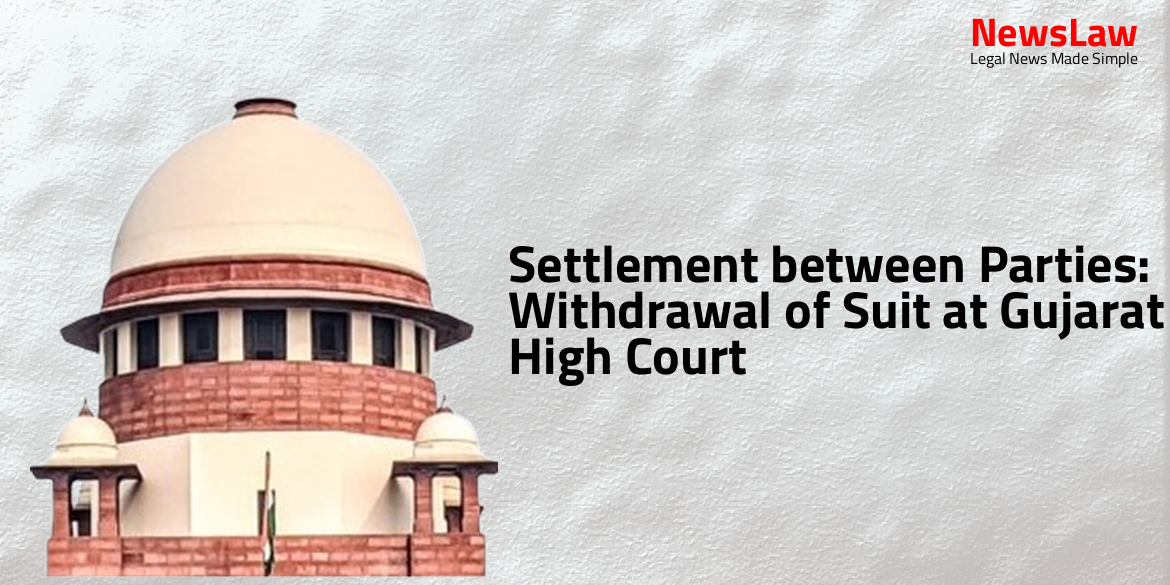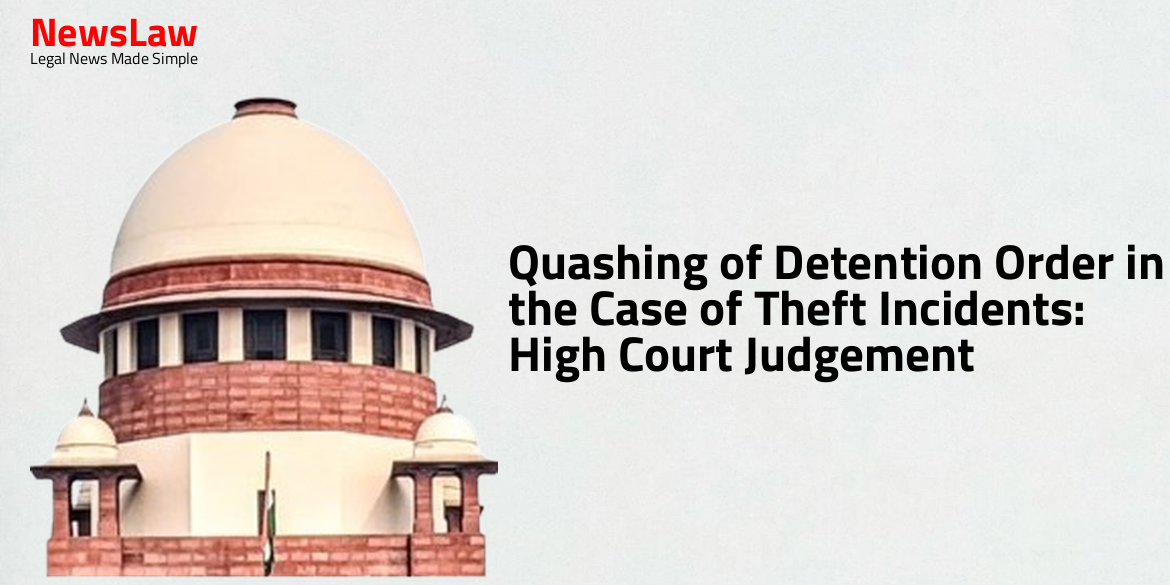Explore the detailed analysis by the Gujarat High Court regarding preventive detention in the case involving public order concerns. The lack of substantial evidence linking the detainee’s actions to a threat to public order raises questions about the validity of the detention order. The judgment highlights essential principles governing preventive detention and emphasizes the need for a ‘live and proximate link’ between the grounds of detention and its purpose. Stay informed about the significance of concrete justifications in cases involving preventive detention.
Facts
- The judgment notes that apart from the statements of witnesses, the FIRs registered and the Panchnama drawn during the investigation, there is no other substantial evidence linking the alleged anti-social activities of the detainee to the breach of public order.
- This lack of concrete evidence presents a significant gap in establishing a direct connection between the detainee’s actions and any threat to public order.
- The court emphasizes the importance of having relevant and cogent material to support accusations of anti-social behavior impacting public order in such cases.
Arguments
- The advocate for the petitioner argues that the detenue’s activities in the criminal cases did not disrupt the even tempo of society or pose a threat to normal life.
- It is contended that the detenue’s involvement in criminal cases did not cause disorder or make it difficult for the system to function under the rule of law.
- The advocate asserts that the detenue’s actions did not disturb public order significantly.
- Learned AGP argues that the detaining authority had sufficient material to order detention, including the petitioner’s confession to theft.
- The three FIRs against Petitioner under IPC chapters XVI and XVII suggest him as a ‘dangerous person’.
- The detaining authority considered additional evidence like panchnama drawing leading to discovery of stolen vehicles.
- The offences related to theft of private vehicles do not amount to breach of public order according to AGP.
- AGP suggests that detaining authority could have revoked petitioner’s bail instead.
Analysis
- The detaining authority showed indifference in passing the detention order promptly after receiving the proposal from the sponsoring authority.
- The petitioner was involved in theft against private individuals, but was enlarged on bail for all three offenses, indicating that ordinary law could prevent further offenses.
- Detaining authority did not consider cancelling bail as an option, leading to a question about the validity of the subjective satisfaction in passing the detention order.
- Citing a recent Supreme Court decision, the Court emphasized that delay in passing detention orders without adequate explanation can cast doubt on the detaining authority’s subjective satisfaction.
- The delay of almost two months in passing the detention order after the petitioner was granted bail in the second offense further raised concerns about the legality and validity of the detention order.
- The offenses alleged in the FIRs against the petitioner do not seem to impact public order significantly, and other penal laws could address the situation adequately.
- The Court highlighted the importance of a ‘live and proximate link’ between the grounds of detention and the purpose of detention, emphasizing the need for a genuine threat to society to justify preventive detention.
- The analysis underscored the essential principles governing preventive detention and the necessity for a valid justification for resorting to such measures.
- The expression ‘public order’ must involve a breach that affects the community or the public at large.
- Serious and aggravated forms of disorder directly impacting the community constitute public order.
- Minor breaches of peace with local significance, primarily harming specific individuals, may not fall under the category of public order.
- Merely disturbing law and order, leading to disorder, may not be sufficient for action under the Preventive Detention Act.
- Actions that significantly affect public order are within the purview of the Act.
- Not every act of assault or injury to specific individuals leads to public disorder.
- The distinction between ‘law and order’ and ‘public order’ is vital, as discussed in the case of Pushker Mukherjee v/s. State of West Bengal.
- The ‘live and proximate link’ between the grounds of detention and the purpose of detention was found to be snapped in the case of the detenu.
- The delay in justifying the detention was not explained by the detaining authority and was not addressed by the High Court despite being raised and argued.
- The High Court did not provide any findings on the delay issue brought up during the proceedings.
- The authority detaining a citizen under PASA law must justify its action when depriving the individual of personal liberty without trial by a competent court.
- The absence of a reply or counter affidavit to the petition leaves the averments unchallenged and uncontroverted.
- Registering FIRs alone does not establish a nexus with the breach of maintaining public order, and there is no other relevant material supporting the invocation of power under section 3(2) of the Act.
- The court is inclined to allow the petition due to the lack of justification for detention under PASA.
Decision
- Direct service is permitted.
- Rule is made absolute accordingly.
- The detenue is ordered to be set at liberty forthwith if not required in any other case.
- The present petition is hereby allowed.
- The impugned order of detention dated 03.12.2023 is quashed and set aside.
Case Title: MOHAMMED HANIF ALIAS PATLI HUSENBHAI SHAIKH THROUGH HIS WIFE JAYNABBIBI MOHAMMEDHANIF SHAIKH Vs. STATE OF GUJARAT
Case Number: R/SCA/1133/2024



